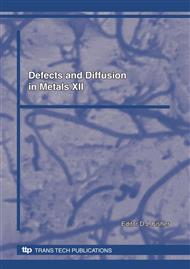p.49
p.55
p.61
p.71
p.85
p.89
p.95
p.105
p.109
Improvement of the Modified Dry-Cup Method for Determination of the Diffusion Coefficients of Gaseous Pollutants in Building Materials
Abstract:
Diffusion and partition coefficients are key parameters for the characterization of building materials as sources and sinks of air pollutants indoors. A simple and rapid experimental method for direct measurement of the diffusion coefficient (D) was presented in a previous article [1]: the modified dry cup method. This method was based upon two existent methodologies, the passive sampling on Tenax TA and the dry cup method, proposed by Haghighat et al. [2]. In the present article, some improvements were made in the experimental set-up in order to obtain more precise results. The previous cup was modified by increasing the number of Tenax tubes, connected to the bottom of the cup, from one to five. The results obtained with both cups were compared. Measurements with single compounds and with three compounds simultaneously were compared in order to evaluate the influence of competition between molecules of different compounds.
Info:
Periodical:
Pages:
109-114
Citation:
Online since:
October 2010
Permissions:
Share:
Citation:


